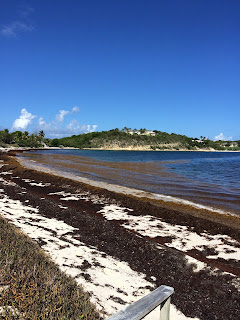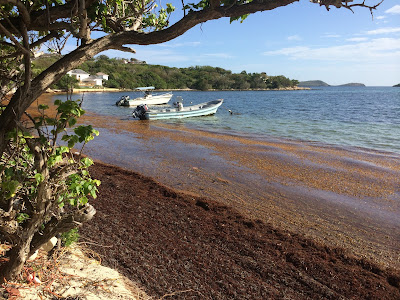Much like a minuscule virus can have terrible consequences to human health, microplastics are a major concern to the ocean’s health. The idea that pollution in the ocean is a threat to sustainability and human life is not new, but scientists and researchers are only beginning to measure the levels and impact of microplastics on the environment. The United Nations Environment Programme (UNEP) recently reported that up to 80 percent of all litter in the oceans is made of plastic and as much as 51 trillion microplastic particles – 500 times more than stars in our galaxy – litter the seas!
 |
| Credit: National Oceanic and Atmospheric Administration |
The Grantham Institute at Imperial College London in their July 2016 report concluded the best way to reduce marine pollution is to manage plastic waste better at the source. What ends up as degraded plastics, most often begins as larger pieces of floating debris. Pollution control can be part of municipal and community plans for waterways, where larger plastics and floatable trash can be subject to UV, wave action and abrasion that can break them down to the microplastic level.
Microplastics are tiny pellets of polyethylene or polyurethane that are 5mm or less in size. These tiny pieces of plastic range from the point of a pencil to the diameter of its eraser.
The largest source of microplastics, though a secondary one, is degraded polyethylene, fibers and small pieces from larger items made from:
a. polystyrene (such as foam cups)
b. nylon (such as rope)
c. polypropylene (such as packaging or carpet fibers)
d. PVC (such as tarps)
The two other primary sources of microplastics are nurdles, which are found in some pillows or small stuffed animals, and microbeads, which are found in facial wash, soaps, and toothpaste.
In 2010, there were 275 million metric tons of plastic generated in 192 coastal countries, which translates to five grocery bags full of plastic for every foot of shoreline in the countries studied (Jambeck et al. 2015). An EPA study concluded that 32 million metric tons of plastic waste were generated in 2012 the US alone (US EPA 2014).
 | |
|
Microplastics are found in aquatic environments at an increased rate and are being mixed in with sand and ingested by wildlife. This tiny trash does not biodegrade and can absorb and carry toxins such as polychlorinated biphenyls (PCBs) that may also be present in the environment. PCBs negatively impact water quality, water temperature, and the health of people and animals – including liver damage, metabolism, reproductive issues, and cancer.
Despite the fact that plastics are used in manufacturing daily across the world, with increasing frequency and volume, very little research has been done so far in this field. The microplastics research that is being done is focused mainly on measuring quantities and locations of the pollution, rather than possible effects on aquatic and human life. One study showed that ingestion of microplastics has occurred in the planktonic food web. Another showed that Pacific female oysters exposed to microplastics produced 38% fewer eggs.
Some of the major sources of microplastics contamination actually come from wastewater treatment plants, where microplastics are not currently being regulated in the effluent and are too tiny to be filtered out. There is a significant contribution from water runoff from landfills as well. Yet, even in remote areas, microplastics have been found in water sources in growing quantities. There were high levels of microplastics found in a large, remote mountain lake, and in deep sea sediment.
Using curb inlet filters or Stormwater BMPs to block access for plastics, trash, and debris from entering storm drains and running directly to the ocean can greatly impact the addition of contributing floating debris. Once plastics and floating trash enter water bodies, the use of debris boom for containment, deflection, and collection of floatables make debris recovery and cleanup operations
much more effective.
With so little known about microplastics, time will tell what devastating impacts may be found from the continuing ingestion and transfer of this common pollutant. It seems prudent to continue to fight plastics, debris, and floating pollutants inland and closer to source wherever possible.
Water quality affects us all. GEI Works is a global solutions provider with a variety of pollution prevention products such as stormwater BMPs and debris boom. Call GEI Works today to find out how we can help you in your fight to keep our oceans free from plastics!




